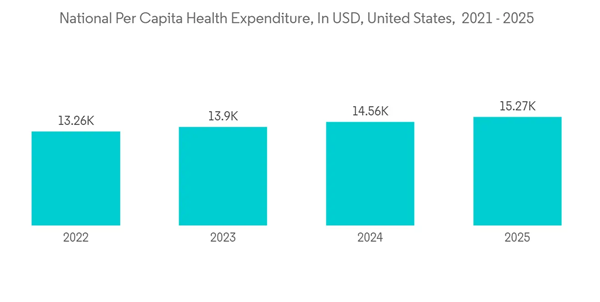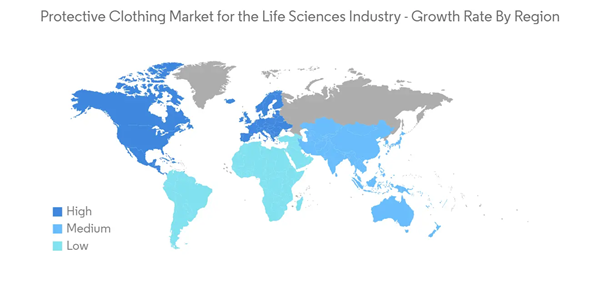During the time frame of the forecast, the protective clothing market for the life sciences industry is expected to register a CAGR of 6.62 %.The spread of COVID-19 around the world had a big effect on the growth of the protective clothing market in many different areas.The biggest part of the effect was the rise in sales and demand in the healthcare sector.COVID-19 had huge effects on health and the economy. When it first started, the sudden spread of the pandemic around the world caused panic.In a short amount of time, the demand for safety gear like face masks, gloves, face shields, air-filtering respirators, goggles, and gowns went up by a lot.
In May 2022, Honeywell announced the launch of two new respiratory products that were NIOSH-certified. Honeywell has been making solutions for respiratory protection for many years. The new products build on that experience and add to its line of personal protective equipment (PPE) for healthcare workers.
The KAMU safety boots will come out in December 2022. They will be made of BAF's Elastollan Thermoplastic Polyurethane (TPU), Elastopan Polyurethane (PU), and Infinergy Expanded Thermoplastic Polyurethane. The cutting-edge materials give workers better grip, long-lasting comfort, energy return, and lightweight cushioning.
This product will be delivered within 2 business days.
Key Highlights
- The life sciences sector can be broadly categorized into three major segments (based on protective clothing applications): pharmaceutical, biotechnology, and medical. Generally, the relative growth of the life sciences segments is linked to the expenditure of regional markets for healthcare and innovation. In the current market scenario, almost all economies, especially developing economies, are increasing their spending on healthcare and innovation.
- Owing to the emerging manufacturing activity in the pharmaceuticals sector, the demand for protective clothing to be used in the preclinical and early-phase drug development and production environments is expected to experience increased demand. For example, the Chinese market is vibrant with preclinical and early-phase drugs, is a growing hub of biotech activity, and creates regional opportunities.
- The World Health Organization says that medical devices are all the tools that are used to diagnose or treat illnesses. This includes everything from surgical scissors to pacemakers and complex scanning equipment.Medical device equipment is classified into Classes I, IIA, IIB, and III based on the risk involved in handling the material.
- The way businesses in each province want to buy PPE in August 2021 is mostly the same as what the results of the PPES in May 2021 showed.According to the May 2021 results, firms in the healthcare and social assistance sectors led shortage expectations.
- Various government organizations recognize companies' efforts for their investment in the life sciences industry. For instance, in October 2021, UNCTAD awarded agencies for promoting new investment in health infrastructure, in the manufacturing of medical devices, pharmaceuticals, and vaccines, in the production of personal protective equipment, digital health, and life science research.
- Also, Levine Leichtman Capital Partners' company Technical Safety Services announced in September 2022 that it would buy CEPA Operations, Inc. ("CEPA"). They are based in Ontario, California. The company's services are performed across the lifecycle of a customer facility and ensure the compliant operation of controlled environments such as clean rooms, bio-safety cabinets, medical gas systems, high-purity water systems, laboratory equipment, and more.
Life Sciences Industry Protective Clothing Market Trends
Increasing Use of Protective Gloves is Boosting the Demand of the Market
- Gloves are among the items that are mostly used as single-use items. Gloves are worn when there is the risk of exposure to bodily fluids, secretions, blood, or excretions, or while handling contaminated equipment. Healthcare professionals, such as doctors, nurses, and laboratory technicians, are at high risk of exposure to such hazards.
- Chemical-resistant gloves protect against peroxide, rocket fuels, very corrosive acids (like nitric acid, sulfuric acid, hydrofluoric acid, and fuming nitric acid), strong bases, alcohols, aldehydes, ketones, esters, and nitro compounds.
- Natural (latex) rubber gloves are a popular general-purpose glove because they are comfortable to wear. Their tensile strength, flexibility, and temperature resistance are all exceptional. These gloves protect employees' hands against most aqueous solutions of acids, alkalis, and salts wear. Their tensile strength, flexibility, and temperature resistance are all exceptional. These gloves protect employees' hands against most aqueous solutions of acids, alkalis, and salts. Their tensile strength, flexibility, and temperature resistance are all exceptional. These gloves protect employees' hands against most aqueous solutions of acids, alkalis, salts, ketones, and abrasions generated by grinding and polishing.
- In the healthcare field, more people are using gloves to protect themselves from pathogenic microorganisms because more workers know how important it is. Because there is a high demand for gloves and it is relatively easy to get into this market segment, there are now a lot of companies selling gloves.
- Gloves are designed to be changed whenever they become contaminated, which may be between patients or during different procedures on the same patient. Hands should be sanitized after the removal of gloves. The OSHA Regulation on Occupational Exposure to Bloodborne Pathogens requires healthcare institutions to provide handwashing facilities to employees and ensure that they wash their hands immediately or as soon as feasible after removing gloves. It even calls for employers to offer hypoallergenic gloves at no cost, thus creating opportunities for vendors with such products in their portfolio.
North America is Expected to Witness a Significant Market Share
- One of the factors influencing employment in the US is the biosciences sector. Venture capital investments and job development across the entire life sciences sector drive the US biotechnology business. Additionally, the biopharma sector contributes significantly to job growth, making it a crucial sector.
- Because of the pandemic, there were severe shortages of PPE, which was a big problem for the nation's healthcare system. The government was at the forefront of the fight against the COVID-19 pandemic because it did not have any infrastructure for protective gear. Because of this, the country had to stop sending protective clothing abroad and start getting it from other countries.
- North America sends most of its technical textiles and protective clothing to Brazil, South Korea, India, China, and Taiwan. Increased safety awareness and laws requiring the use of protective garments. In addition to the major manufacturers, small businesses are also concentrating on creating cutting-edge protective apparel that is used to make safety gloves and jackets.
- Although PPE kits were meant to be disposed of, importing these items met with serious issues when they were washed and repackaged for re-use. The penetration of such duplicate products led the FDA to launch an investigation. The FDA released a notice recommending health care facilities and providers not to purchase imported medical gloves or products from companies listed in its list of import alerts to restrict further penetration of used disposable medical gloves and N95 respirators.
- Most healthcare centers work as chains, so it's likely that business will be better for suppliers who can reach all of North America and offer products for health imaging, sterile processing, surgical operations, and patient handling. They are expected to go for a one-stop purchase with discrete delivery benefits. With field representatives and distribution centers across the countries, the suppliers can be more attentive and provide one-on-one service, making a huge difference in the market.
Life Sciences Industry Protective Clothing Industry Overview
By nature, the market for protective clothing in the life sciences sector is highly concentrated.The main growth strategies used by regional companies to survive the fierce competition are product launches, high expenditures on research and development, partnerships, and acquisitions.Major companies, like E. I. DuPont de Nemours and Company, Kimberly Clark Corporation, Ansell Limited, and 3M Company, design and manufacture clothes to protect medical personnel from serious workplace injuries.In May 2022, Honeywell announced the launch of two new respiratory products that were NIOSH-certified. Honeywell has been making solutions for respiratory protection for many years. The new products build on that experience and add to its line of personal protective equipment (PPE) for healthcare workers.
The KAMU safety boots will come out in December 2022. They will be made of BAF's Elastollan Thermoplastic Polyurethane (TPU), Elastopan Polyurethane (PU), and Infinergy Expanded Thermoplastic Polyurethane. The cutting-edge materials give workers better grip, long-lasting comfort, energy return, and lightweight cushioning.
Additional Benefits:
- The market estimate (ME) sheet in Excel format
- 3 months of analyst support
This product will be delivered within 2 business days.
Table of Contents
1 INTRODUCTION
4 MARKET INSIGHTS
5 MARKET DYNAMICS
6 MARKET SEGMENTATION
7 COMPETITIVE LANDSCAPE
Companies Mentioned (Partial List)
A selection of companies mentioned in this report includes, but is not limited to:
- E. I. DuPont De Nemours and Company
- Kimberly Clark Corporation
- Ansell Limited
- 3M Company
- Honeywell International Inc.
- Lakeland Industries Inc.
- Irudek Group
- Berkshire Corporation
- Kappler Inc.
- Tronex International Inc.
Methodology

LOADING...










